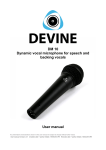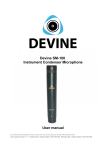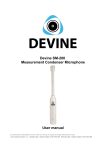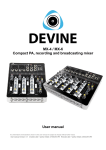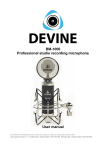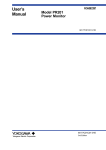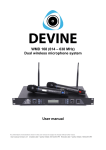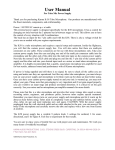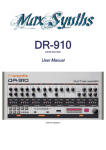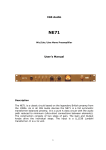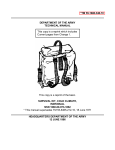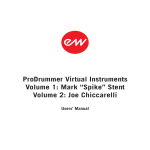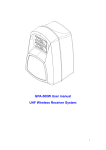Download MIC-DS Professional drum microphone kit User manual - Bax
Transcript
MIC-DS Professional drum microphone kit User manual Any information and illustrations shown in this user manual are subject to change without further notice. User manual version: 1.0 Creation date + author initials: 27-01-2014 RV Revision date + author initials: 27-01-2014 RV Box contents Box contents: 1x BM-10 bass drum microphone 4x TM-10 snare/tom microphone 2x CM-10 overhead condenser microphone 4x SDH037 shell clamps 2x SKSE115 microphone clamps 2x W-20 windscreen for condenser microphones 1x aluminum transport case Unit and accessory inspection - If the unit is not going to be used for a longer period of time, disconnect it and store it in a dust-free environment. - Always check the unit for possible damage before use. If you suspect that something is wrong with the unit, do not connect it! When you suspect that your unit is broken or damaged, contact your local dealer or a certified technician to inspect the unit. Note: Illustrations shown in this manual may vary from the actual product. Any information and illustrations shown in this user manual are subject to change without further notice. User manual version: 1.0 Creation date + author initials: 27-01-2014 RV Revision date + author initials: 27-01-2014 RV Use of the microphone kit The MIC-DS drum kit is a professional microphone kit, consisting of 7 high-quality drum microphones and all needed accessories to be able to record a complete drum kit. With the separate bass drum and tom/snare microphones, combined with the overhead microphones, you are able to create your own sound mix on any PA-mixer or audio interface. Thanks to the high sensitivity and the condenser construction of the included overhead microphones, even cymbals are recorded in high quality. It is also possible to use the overhead microphones for basic vocal setups, for example when recording choirs or larger vocal ensembles. Bass drum microphone: The bass drum microphone, a BM-10 microphone, is positioned near the bass drum. This microphone has a cardioid polar pattern and can be positioned virtually anywhere near the bass drum. To create the best sound, you have to experiment with different setups, as the best sound of each bass drum may vary as all brands make their bass drums in a different way. Tom/snare microphones: The TM-10 tom/snare microphones can be connected to the edge of a snare drum or tom with the special tom mounts. Mount the microphones on the special holders and experiment with optimal microphone positioning. Overhead microphones: Use large overhead microphone stands and position both CM-10 microphones towards the drum kit. By placing the microphones in a overhead position, the sound of cymbals will be recorded just as good as the sound of the snares, toms and bass drum. This grants you the ability to record all sound sources in optimal quality. Thanks to the high SPL rating of the microphones, it is possible to record loud snares, toms, bass drums and cymbals without distortion. However, you may want to experiment with the input signals on your mixer, by changing gain settings and maybe activating certain pads to decrease input levels. Each microphone has its own characteristics, which matches them with certain purposes. But if you want to experiment with different setups, it is always possible to experiment with other microphones to create the right sound. As every microphone type of every brand has its unique characteristics, it is always possible and recommended to experiment with microphones setups to create the best sound. All microphone clips are equipped with 5/8” thread for placement on microphone stands. It is also possible to use the special snare/tom clamps, to mount the tom/snare microphones on the edges of the shells. This way, a setup with large amounts of microphone stands are avoided and for most applications this gives the best result as you are able to change the microphone angle for better pick-up of the shell sound. IMPORTANT: Phantom power The condenser microphones require +48V phantom power from a PA-mixer, studio mixer, audio interface or phantom power supply. Consult the manual of your equipment or contact your local dealer when in doubt if your equipment is capable of providing a +48V voltage. Dynamic microphones do not need +48V power supply, but nothing will happen if you add a dynamic microphone on a group of +48V activated channels. The condenser microphones will not work properly when there is no +48V voltage activated. Always check this if you suspect that your microphone might be damaged or broken. Protect your microphone: The Devine microphones are equipped with very sensitive electronics to provide optimal audio performance. Make sure the microphones are not exposed to severe shocks, collision, drops from high altitude or any situations that may cause permanent damage. Improper use of the microphone is not covered by warranty. Always transport the microphone in the original case, or in a flightcase with proper foam inlay. Transporting Any information and illustrations shown in this user manual are subject to change without further notice. User manual version: 1.0 Creation date + author initials: 27-01-2014 RV Revision date + author initials: 27-01-2014 RV the microphone without proper protection may cause permanent damage and will not be covered by warranty. Connect your microphone to a mixer or audio interface: The microphones use a 3-pin XLR connector for connection with your mixer or audio-interface (cables not included). It is recommended to check the settings on your audio equipment before connecting the microphone. Check your equipment for the following settings: Mixer/Audio interface: - Gain set to the 0-point (in the most final counter-clockwise position) - Compression/lowcut settings positioned in the off or most neutral position - EQ settings on the most neutral position - Pan/Balance settings on the most neutral position - Volume fader or potentiometer set to the lowest possible position - Phantom power in the ‘on’ position for condenser mics (mostly a button per channel, or a group of channels) Microphone: - Steady positioning on a microphone stand or mounted on a shell, with the included microphone clip - Experiment with the microphone positions to achieve perfect sound. After you checked the settings above, you may start recording the audio source. Placing the audio source as near to the microphone as possible, provides the best audio quality and grants you the ability to reduce overall gain settings, which prevents audio feedback and noise. Turn the volume parameter (potentiometer or fader) on the ‘0 dB’ position for the best audio performance and slowly increase the gain, until slight clipping (mostly indicated with a (LED) VU meter or LED) or distortion is noticed. Any information and illustrations shown in this user manual are subject to change without further notice. User manual version: 1.0 Creation date + author initials: 27-01-2014 RV Revision date + author initials: 27-01-2014 RV Troubleshooting Problem Possible Cause Solution No sound, or very low sound signal No phantom power for condenser microphones Connect or activate phantom power supply Volume set too low Increase incoming volume and gain on your mixer, interface or other sound processing device Microphone positioned too far away Place the microphone closer to the sound source Rattling and cracking sounds Moist inside the microphone Let the microphone dry on room temperature and avoid use of the microphone in humid or moist environments. Do not let the microphone come in contact with water or liquids. Loud high frequencies coming from the speakers Microphone positioned too close to Move the microphone further away the speakers, which causes from the speakers, or change the feedback position to prevent the microphone to be aimed directly at the speakers. Interruptance of the microphone signal Loose cable or broken cable Check if the cable is plugged into the microphone correctly. If that does not solve the problem, try to change the cable. Distortion and/or noise in the captured sound Too much airflow caused by vocal airflows Use a pop filter (sold separately) Too much airflow caused by wind (outdoor use) Use the windscreen (included) Any information and illustrations shown in this user manual are subject to change without further notice. User manual version: 1.0 Creation date + author initials: 27-01-2014 RV Revision date + author initials: 27-01-2014 RV Technical specifications - complete microphone kit for acoustic drum kits - consists of: 1x bassdrum mic, 4x snare/tom mic, 2x overhead mic - 4 tom/snare clamps and two windscreens included - all microphones equipped with 5/8" microphone stand threads - all tom/snare clamps equipped with 3/8" adapters - all microphones equipped with microphone stand clips BM-10 bass drum microphone - dynamic microphone for bass drum - built-in windscreen - cardioid (uni-directional) polar pattern - frequency response: 50 Hz - 14 kHz - sensitivity: -58 dB (+/- 3 dB) at 0dB, 1V/Pa at 1 kHz - output impedance: 250 Ohms (+/- 30%) at 1 kHz TM-10 snare/tom microphone - dynamic microphone for snare drums and toms - built-in windscreen - cardioid (uni-directional) polar pattern - frequency response: 50 Hz - 14 kHz - sensitivity: -56 dB (+/- 3 dB) at 0dB, 1V/Pa at 1 kHz - output impedance: 250 Ohms (+/- 30%) at 1 kHz CM-10 overhead microphone - condenser microphone for overhead recording (drums, choirs, etc.) - cardioid (uni-directional) polar pattern - frequency response: 50 Hz - 18 kHz - sensitivity: -45 dB (+/- 3 dB) at 0dB, 1V/Pa at 1 kHz - output impedance: 200 Ohms (+/- 30%) at 1 kHz - max. SPL: 136 dB (1 kHz, <1% T.H.D.) - S/N ratio: 60dB - phantom power requirements: 9 - 52V SDH037 drum clamp - practical clamp for direct mounting on toms, snares etc. - equipped with standard 5/8" thread for microphone clip mounting - integrated cable clip for optimal cable management W-20 microphone windscreen - prevents wind noise due to large airflows - designed for the CM-10 condenser microphones BM-10 TM-10 CM-10 Any information and illustrations shown in this user manual are subject to change without further notice. User manual version: 1.0 Creation date + author initials: 27-01-2014 RV Revision date + author initials: 27-01-2014 RV






